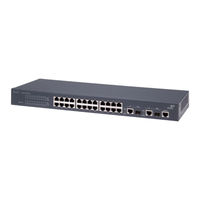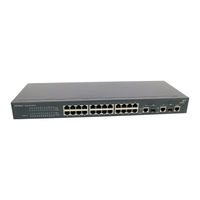3Com Switch 4210 52-Port Manuals
Manuals and User Guides for 3Com Switch 4210 52-Port. We have 3 3Com Switch 4210 52-Port manuals available for free PDF download: Configuration Manual, Getting Started, Datasheet
3Com Switch 4210 52-Port Configuration Manual (870 pages)
Switch 4210 Family
Brand: 3Com
|
Category: Network Hardware
|
Size: 9 MB
Table of Contents
-
-
-
Introduction11
-
-
-
Introduction23
-
-
-
CLI Views44
-
CLI Features48
-
Online Help48
-
Command Edit50
-
-
Introduction52
-
-
Introduction57
-
-
-
-
-
DNS Overview98
-
-
-
-
-
-
Overview145
-
-
-
-
Introduction161
-
-
-
-
-
-
Overview179
-
-
DLDP Packets180
-
DLDP Status182
-
DLDP Timers182
-
-
-
Overview192
-
-
Overview202
-
-
Enabling MSTP230
-
-
Enabling MSTP234
-
-
Introduction241
-
-
-
Introduction245
-
-
-
Multicast Models257
-
-
-
-
X Configuration
290
-
-
-
1 Aaa Overview
320-
-
Authentication320
-
Authorization320
-
Accounting321
-
-
-
-
-
-
Related Concepts366
-
-
-
1 Dhcp Overview
387 -
-
Enabling DHCP393
-
-
-
-
Introduction422
-
-
-
-
ACL Assignment451
-
-
-
Overview459
-
-
Priority Marking466
-
Traffic Policing466
-
Queue Scheduling468
-
Burst469
-
-
Displaying Qos483
-
-
-
-
Cluster
503-
Cluster504
-
Cluster Overview504
-
-
-
Poe Overview532
-
-
-
Snmp Overview545
-
Snmp Versions545
-
Supported Mibs545
-
Displaying Snmp550
-
Displaying Rmon556
-
-
-
SSH Overview582
-
-
-
-
-
-
Advertisement
3Com Switch 4210 52-Port Getting Started (74 pages)
Switch 4210 Series
Table of Contents
-
-
Overview7
-
-
Power System11
-
-
-
Pin - Outs
57-
Modem Cable58
-
Products
59-
Contact Us60
-
3Com Switch 4210 52-Port Datasheet (8 pages)
SWITCH 4210 10/100 Series
Advertisement
Advertisement


